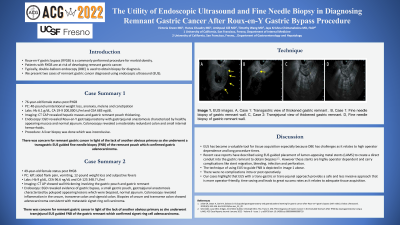Back


Poster Session D - Tuesday Morning
Category: Interventional Endoscopy
D0468 - The Utility of Endoscopic Ultrasound and Fine Needle Biopsy in Diagnosing Remnant Gastric Cancer After Roux-en-Y Gastric Bypass Procedure
Tuesday, October 25, 2022
10:00 AM – 12:00 PM ET
Location: Crown Ballroom

Has Audio

VIctoria Green, MD
UCSF Fresno
Fresno, CA
Presenting Author(s)
Victoria A. Green, MD, Hunza Chaudhry, MD, Amitpaul Gill, MD, Timothy Wang, MD, Jayakrishna Chintanaboina, MD
UCSF-Fresno, Fresno, CA
Introduction: Roux-en-Y gastric bypass (RYGB) procedure is commonly performed for severe obesity. These patients are at risk of developing remnant gastric cancer. Double-balloon endoscopy (DBE) is typically used to obtain a biopsy. We present two cases of remnant gastric cancer diagnosed using endoscopic ultrasound (EUS).
Case Description/Methods: Case 1 is a 76-year-old female status post RYGB who presented with 40-pound weight loss, anorexia and constipation. Labs showed hemoglobin of 6.1 g/dL. Computed tomography (CT) of the chest, abdomen and pelvis revealed hepatic masses and gastric remnant thickening. CA 19-9 was 200,000 U/ml and CEA was 683 ng/dL. Esophagogastroduodenoscopy (EGD) revealed Roux-en-Y gastrojejunostomy with healthy appearing mucosa and a normal jejunum. Colonoscopy showed internal hemorrhoids. Liver biopsy was inconclusive. Concern for remnant gastric cancer, in light of no obvious primary, prompted transgastric EUS guided fine needle biopsy (FNB) of the remnant pouch which confirmed gastric adenocarcinoma.
Case 2 is a 49-year-old female status post RYGB who presented with left flank pain,12-pound weight loss and fevers. Labs showed hemoglobin 9 g/dL. CT of the abdomen showed wall thickening involving the gastric pouch and gastric remnant. CEA was 96.6 ng/dL and CA-125 was 348.7 U/ml. EGD revealed a small gastric pouch, gastrojejunal anastomosis characterized by polypoid appearing lesions which were biopsied and found to be benign, and a normal jejunum. Colonoscopy showed inflammation in the cecum and transverse colon and biopsies revealed adenocarcinoma consistent with metastatic signet ring cell carcinoma. Transjejunal EUS guided FNB of the gastric remnant confirmed signet ring cell adenocarcinoma.
Discussion: EUS is a valuable tool for tissue acquisition especially because DBE has challenges of high operator dependence and long procedure times. Case reports have described EUS guided placement of lumen-apposing metal stents (LAMS) to create a conduit into the gastric remnant to obtain biopsies. However, LAMS are highly operator dependent and carry complications of stent migration, bleeding, infection and perforation. The EUS guided FNB technique is shown in image 1. There were no complications intra or post operatively. Our cases show that EUS with a trans-gastric or trans-jejunal approach provides a less invasive approach that is more operator-friendly, time saving and yields adequate tissue acquisition.

Disclosures:
Victoria A. Green, MD, Hunza Chaudhry, MD, Amitpaul Gill, MD, Timothy Wang, MD, Jayakrishna Chintanaboina, MD. D0468 - The Utility of Endoscopic Ultrasound and Fine Needle Biopsy in Diagnosing Remnant Gastric Cancer After Roux-en-Y Gastric Bypass Procedure, ACG 2022 Annual Scientific Meeting Abstracts. Charlotte, NC: American College of Gastroenterology.
UCSF-Fresno, Fresno, CA
Introduction: Roux-en-Y gastric bypass (RYGB) procedure is commonly performed for severe obesity. These patients are at risk of developing remnant gastric cancer. Double-balloon endoscopy (DBE) is typically used to obtain a biopsy. We present two cases of remnant gastric cancer diagnosed using endoscopic ultrasound (EUS).
Case Description/Methods: Case 1 is a 76-year-old female status post RYGB who presented with 40-pound weight loss, anorexia and constipation. Labs showed hemoglobin of 6.1 g/dL. Computed tomography (CT) of the chest, abdomen and pelvis revealed hepatic masses and gastric remnant thickening. CA 19-9 was 200,000 U/ml and CEA was 683 ng/dL. Esophagogastroduodenoscopy (EGD) revealed Roux-en-Y gastrojejunostomy with healthy appearing mucosa and a normal jejunum. Colonoscopy showed internal hemorrhoids. Liver biopsy was inconclusive. Concern for remnant gastric cancer, in light of no obvious primary, prompted transgastric EUS guided fine needle biopsy (FNB) of the remnant pouch which confirmed gastric adenocarcinoma.
Case 2 is a 49-year-old female status post RYGB who presented with left flank pain,12-pound weight loss and fevers. Labs showed hemoglobin 9 g/dL. CT of the abdomen showed wall thickening involving the gastric pouch and gastric remnant. CEA was 96.6 ng/dL and CA-125 was 348.7 U/ml. EGD revealed a small gastric pouch, gastrojejunal anastomosis characterized by polypoid appearing lesions which were biopsied and found to be benign, and a normal jejunum. Colonoscopy showed inflammation in the cecum and transverse colon and biopsies revealed adenocarcinoma consistent with metastatic signet ring cell carcinoma. Transjejunal EUS guided FNB of the gastric remnant confirmed signet ring cell adenocarcinoma.
Discussion: EUS is a valuable tool for tissue acquisition especially because DBE has challenges of high operator dependence and long procedure times. Case reports have described EUS guided placement of lumen-apposing metal stents (LAMS) to create a conduit into the gastric remnant to obtain biopsies. However, LAMS are highly operator dependent and carry complications of stent migration, bleeding, infection and perforation. The EUS guided FNB technique is shown in image 1. There were no complications intra or post operatively. Our cases show that EUS with a trans-gastric or trans-jejunal approach provides a less invasive approach that is more operator-friendly, time saving and yields adequate tissue acquisition.

Figure: Image 1. EUS images. A, Case 1: Transgastric view of thickened gastric remnant. B, Case 1: Fine needle biopsy of gastric remnant wall. C, Case 2: Transjejunal view of thickened gastric remnant. D, Fine needle biopsy of gastric remnant wall.
Disclosures:
Victoria Green indicated no relevant financial relationships.
Hunza Chaudhry indicated no relevant financial relationships.
Amitpaul Gill indicated no relevant financial relationships.
Timothy Wang indicated no relevant financial relationships.
Jayakrishna Chintanaboina indicated no relevant financial relationships.
Victoria A. Green, MD, Hunza Chaudhry, MD, Amitpaul Gill, MD, Timothy Wang, MD, Jayakrishna Chintanaboina, MD. D0468 - The Utility of Endoscopic Ultrasound and Fine Needle Biopsy in Diagnosing Remnant Gastric Cancer After Roux-en-Y Gastric Bypass Procedure, ACG 2022 Annual Scientific Meeting Abstracts. Charlotte, NC: American College of Gastroenterology.
